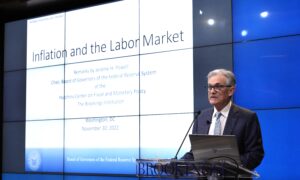Fed Chair Offers Guidance
CommentaryFederal Reserve (Fed) Chairman Jerome Powell spoke frankly on Nov. 30. His thoughtful and balanced talk made clear that the Fed sees the inflation fight as its priority. He explained the uncertain timing between Fed action and its impact on inflation but made clear that further interest rate increases are integral to the effort. Unlike so much that comes out of Washington, Powell’s talk was long on perspective and short on promises. In other words, it addressed practical realities. He did allude to the possibility that the Fed might moderate the pace of interest rate increases, attributing such a possibility to technical considerations and not—as so much media intimates—as a sign that the inflation fight might be winding down. The forthrightness with which Powell spoke was a far cry from his behavior in 2021. Then, even as inflation built quickly and in a frightening way, he joined with Treasury Secretary Janet Yellen and insisted, against all the evidence, that the price pressure was “transitory.” In retrospect, it has become clear that his position last year was more political than anything else. As 2021 approached its close, Powell’s term as Fed chairman was also drawing to an end. He needed President Joe Biden’s support to secure a second term, and he knew that the president wanted to downplay the otherwise obvious inflationary pressure for his own political reasons. Powell spoke accordingly. A shopping cart in a supermarket as inflation affected consumer prices in Manhattan, N.Y., on June 10, 2022. (Andrew Kelly/Reuters) Since securing reappointment, Powell and the Fed have taken on a very different perspective. First thing in 2022, the Fed has made clear, as Powell did in this recent talk, that it is focused on quelling inflation. Monetary policymakers began to act this past March. They started to raise short-term interest rates and reverse the quantitative easing program under which they had until they pushed additional liquidity into financial markets. Since, the Fed has pursued this new line of action aggressively, raising interest rates, occasionally by 0.75 percentage points at a go, and increasing short-term rates by a cumulative 3.7 percentage points from March levels through early December. Powell makes abundantly clear in this latest talk that Fed policymakers will stick to this path. He explained that some inflation measures seem to have moderated but that in other important ways, inflation remains stubbornly high, and it is on this matter where the Fed must have its focus. He outlined what must have been a careful and thorough Fed analysis of the inflation situation and why, at best, pressures will persist well into 2023. Notably, Powell indirectly contradicted some media speculation that policymakers would ease their position on acceptable inflation, perhaps abandoning its previous target of 2.0 percent inflation in favor of 4.0 percent. By recommitting the Fed to its original 2.0 percent target, he has, hopefully, scotched such speculation. Although Powell assured all that interest rate increases would continue, he did suggest that the size of each rate hike might be moderate—that perhaps instead of 0.75 percentage point increments, the Fed might raise rates only 0.5 percentage points at a time, including the policy adjustment scheduled for later this month. Much media discussion has mistakenly taken this comment to mean that the Fed may be nearing the end of its anti-inflation fight. But this interpretation, though full of the excitement that the media loves, is nowhere near Powell’s meaning. Instead, he couched this potential moderation as a gesture to the uncertain lags with which interest rate increases affect the economy and inflation. He explained that it is only prudent to moderate the pace for a while because we may not have seen the full economic and inflationary effect of past aggressive rate increases. Rather than nearing the end of the inflation fight, Powell made it plain that interest rates would ultimately have to rise higher. For obvious reasons, the speech contained no speculation on how high-interest rates would ultimately have to go. Had he made such a statement, it would have caused needless gyrations in financial markets and otherwise committed the Fed impracticably to a single target in a world that is constantly changing. But if Powell must hold his ultimate interest rate target close to his chest, history can speak on the subject. In the past, interest rates have had to rise to or above the ongoing inflation rate before they can have much effect on quelling the pressure. With various inflation measures running regularly between 5 and 7 percent, interest rates—unless the economy gets very lucky—will have to rise much higher than they are today, almost double. And this ultimate necessity will have to occur in whatever increments the Fed chooses to make the climb. Views expressed in this article are the opinions of the author and do not necessar

Commentary
Federal Reserve (Fed) Chairman Jerome Powell spoke frankly on Nov. 30. His thoughtful and balanced talk made clear that the Fed sees the inflation fight as its priority. He explained the uncertain timing between Fed action and its impact on inflation but made clear that further interest rate increases are integral to the effort.
Unlike so much that comes out of Washington, Powell’s talk was long on perspective and short on promises. In other words, it addressed practical realities. He did allude to the possibility that the Fed might moderate the pace of interest rate increases, attributing such a possibility to technical considerations and not—as so much media intimates—as a sign that the inflation fight might be winding down.
The forthrightness with which Powell spoke was a far cry from his behavior in 2021. Then, even as inflation built quickly and in a frightening way, he joined with Treasury Secretary Janet Yellen and insisted, against all the evidence, that the price pressure was “transitory.” In retrospect, it has become clear that his position last year was more political than anything else. As 2021 approached its close, Powell’s term as Fed chairman was also drawing to an end. He needed President Joe Biden’s support to secure a second term, and he knew that the president wanted to downplay the otherwise obvious inflationary pressure for his own political reasons. Powell spoke accordingly.

Since securing reappointment, Powell and the Fed have taken on a very different perspective. First thing in 2022, the Fed has made clear, as Powell did in this recent talk, that it is focused on quelling inflation. Monetary policymakers began to act this past March. They started to raise short-term interest rates and reverse the quantitative easing program under which they had until they pushed additional liquidity into financial markets. Since, the Fed has pursued this new line of action aggressively, raising interest rates, occasionally by 0.75 percentage points at a go, and increasing short-term rates by a cumulative 3.7 percentage points from March levels through early December.
Powell makes abundantly clear in this latest talk that Fed policymakers will stick to this path. He explained that some inflation measures seem to have moderated but that in other important ways, inflation remains stubbornly high, and it is on this matter where the Fed must have its focus. He outlined what must have been a careful and thorough Fed analysis of the inflation situation and why, at best, pressures will persist well into 2023. Notably, Powell indirectly contradicted some media speculation that policymakers would ease their position on acceptable inflation, perhaps abandoning its previous target of 2.0 percent inflation in favor of 4.0 percent. By recommitting the Fed to its original 2.0 percent target, he has, hopefully, scotched such speculation.
Although Powell assured all that interest rate increases would continue, he did suggest that the size of each rate hike might be moderate—that perhaps instead of 0.75 percentage point increments, the Fed might raise rates only 0.5 percentage points at a time, including the policy adjustment scheduled for later this month. Much media discussion has mistakenly taken this comment to mean that the Fed may be nearing the end of its anti-inflation fight. But this interpretation, though full of the excitement that the media loves, is nowhere near Powell’s meaning.
Instead, he couched this potential moderation as a gesture to the uncertain lags with which interest rate increases affect the economy and inflation. He explained that it is only prudent to moderate the pace for a while because we may not have seen the full economic and inflationary effect of past aggressive rate increases. Rather than nearing the end of the inflation fight, Powell made it plain that interest rates would ultimately have to rise higher.
For obvious reasons, the speech contained no speculation on how high-interest rates would ultimately have to go. Had he made such a statement, it would have caused needless gyrations in financial markets and otherwise committed the Fed impracticably to a single target in a world that is constantly changing. But if Powell must hold his ultimate interest rate target close to his chest, history can speak on the subject. In the past, interest rates have had to rise to or above the ongoing inflation rate before they can have much effect on quelling the pressure.
With various inflation measures running regularly between 5 and 7 percent, interest rates—unless the economy gets very lucky—will have to rise much higher than they are today, almost double. And this ultimate necessity will have to occur in whatever increments the Fed chooses to make the climb.
Views expressed in this article are the opinions of the author and do not necessarily reflect the views of The Epoch Times.












